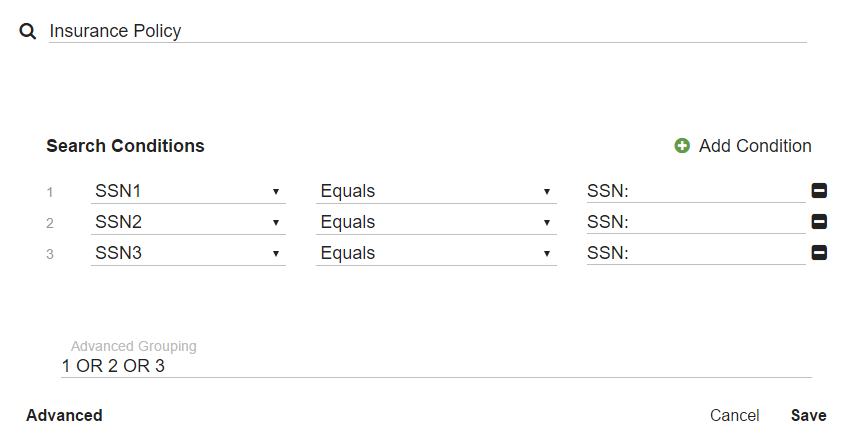In addition to searching for documents based on a single Index Field, such as a vendor name (or the lack of the vendor name), users can also search more than one Field in the same Search for a single keyword or phrase. This can save a lot of time finding related documents, such as all the purchase orders from Acme Inc. produced in the last thirty days. Configure a Multi-Field Search so that more than one criterion has exactly the same prompt value. When users run the Search, they see one prompt whose input value feeds all of the assigned criteria. When configuring a Multi-Field Search, you must use the Advanced Grouping settings to concatenate the values with the OR logical operator.
Example: Search Multiple Fields
Create a Search called “Insurance Policy” with multiple fields for a social security number (SSN) where one SSN is entered into each Field. A user performing a search does not know which Field might contain the SSN and does not want to run the Search multiple times or key the SSN into multiple Search prompts. By configuring the Search for multi-field searching, this problem is easily solved.
When this Search is executed, the user will be prompted to enter only a single social security number, but the Search will look in all the Indexed Fields defined in the Search with that prompt value for the data.
Example: Search Invoices
In an invoice approval process, an Accounts Payable clerk needed to flag any invoices that are above a dollar threshold for a given cost center.
Create a Search called “Invoice Approval” which should return any Sales invoice > $5,000 or any IT invoice > $2,500. This Search would be impossible with the standard query logic. By default, the Search will be an AND-based search (1 and 2 and 3 and 4 and 5). To enable OR-based searching, change the settings in the Advanced Grouping text box using a combination of parenthesis as well as OR statements to ((1 and 2) or (3 and 4)) and 5.

